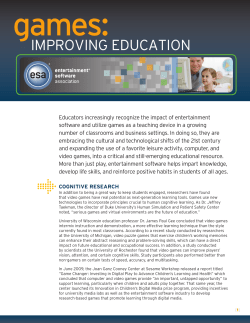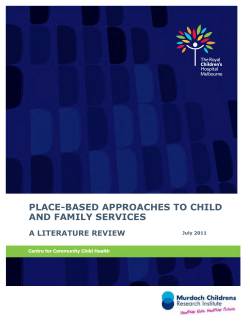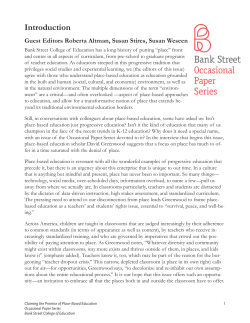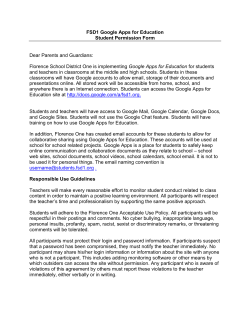
Student Gains From Place-Based Education
Fact Sheet #2 Revised: June 2013 Student Gains From Place-Based Education Place-based or environment-based education uses the environment as an integrating context (EIC) across disciplines. It is characterized by exploration of the local community and natural surroundings, hands-on experiences of environmental discovery and problem-solving, interdisciplinary curricula, team teaching, and learning that accommodates students’ individual skills and abilities. Research shows that this approach delivers many benefits to students. im yK Photo b r ze Ke Higher Test Scores and Grades w la Students in schools and classrooms that use the environment as an integrating context for learning score higher on standardized tests in reading, writing, math, science, and social studies. Studies that have found higher test scores as a consequence of place-based education include: surveys of 40 schools across the nation with EIC programs, including comparisons of students in EIC versus traditional classrooms in 14 of these schools (Lieberman & Hoody 1998); a Washington study that matched 77 EIC schools with demographically equivalent schools without environmental education (Bartosh 2003); a California study that matched eight classes with EIC programs with equivalent classes without EIC (SEER 2000); and a national study that found improved test scores in seven schools that adopted EIC approaches (NEETF 2000). Other results from these studies indicate that students in EIC programs tend to improve their overall GPA, stay in school longer, and receive higher than average scholarship awards. They are perceived by their teachers to exhibit a Ch se i increased pride in their u Lo by Photo accomplishments and greater engagement and enthusiasm for learning. This last finding was replicated in a survey of 55 schools that represented four place-based education programs (Duffin et al. 2004) and an evaluation of ten middle schools in South Carolina that adopted EIC approaches (Falco 2004). More Advanced Critical Thinking Skills A Florida study of 400 ninth and twelfth graders in 11 schools compared students’ critical thinking skills in EIC classrooms versus traditional classrooms (Ernst & Monroe 2004). At both grade levels, the EIC programs significantly raised students’ scores on the Cornell Critical Thinking Test. Teacher interviews indicated that EIC programs require students to integrate multiple disciplines, formulate Photo by Michael Duffin and test hypotheses, investigate issues, take responsibility for their own learning, reflect on what they learn, and connect their learning to their communities. Children, Youth and Environments Center for Community Engagement University of Colorado www.colorado.edu/cye www.ucdenver.edu/cye Greater Achievement Motivation Greater achievement motivation is associated with greater engagement in schoolwork, which improves academic performance. In the Florida study of 400 ninth and twelfth grade students described above, students in classrooms with EIC programs and traditional programs filled out an Achievement Motivation Inventory (Athman & Monroe 2004). At both grade levels, students in the EIC classrooms scored significantly higher in achievement motivation compared with students in the control classrooms. Students and teachers attributed this gain to the use of the local environment, the application of learning to real-life issues, and the ability to tailor learning experiences to students’ interests and strengths. More Responsible Behavior and Environmental Stewardship Students exposed to EIC programs display reduced discipline and classroom management problems (Falco 2004, Lieberman & Hoody 1998, NEETF 2000, SEER 2000), better attendance (SEER 2000), and more responsible behavior in their school and community (Bartosh 2003). The more exposure that students have to EIC programs, the more they report attachment to place, time spent outdoors, civic engagement, and environmental stewardship (Duffin et al. 2004). Student Gains from Extended Stays at Outdoor Education Centers In addition to place-based education which explores the local community and surrounding natural areas, some schools take students to environmental centers distant from their homes. A California study compared at-risk sixth graders who attended outdoor programs to study ecology and earth science with control groups from the same schools (American Institutes of Research 2005). Students in the outdoor programs significantly raised their science scores and maintained greater science knowledge in a 10-week follow-up. They also showed more cooperation and conflict resolution skills (student assessments and teacher ratings), more positive environmental behaviors (parents’ ratings), and better problem solving, motivation to learn, and classroom behavior (teachers’ ratings). References Athman, Julie and Monroe, Martha. 2004. The effects of environment-based education on students’ achievement motivation. Journal of Interpretation Research, 9(1): 9-25. Bartosh, Oksana. 2003. Environmental Education: Improving Student Achievement. Thesis for a Masters in Environmental Studies, Evergreen State College, Olympia, WA. Duffin, Michael., Powers, A., Tremblay, George, and PEER Associates. 2004. Place-based Education Evaluation Collaborative: Report on Cross-program Research and Other Program Evaluation Activities, 2003-2004. (http:// www.peecworks.org/PEEC/PEEC_Reports) Ernst, Julie Athman and Monroe, Martha. 2004. The effect of environmentbased education on students’ critical thinking skills and disposition toward critical thinking. Environmental Education Research, 10(4): 507-522. Falco, Edward H. 2004. Environment-based Education: Improving Attitudes and Academics for Adolescents. Evaluation report for South Carolina Department of Education. Lieberman, Gerald A. and Hoody, Linda. 1998. Closing the Achievement Gap. San Diego, CA: State Education and Environment Roundtable. National Environmental Education Training Foundation (NEETF). 2000. Environment-based Education: Creating High Performance Schools and Students. Washington, DC: Author. State Education and Environment Roundtable (SEER). 2000. California Student Assessment Project: The Effects of Environment-based Education on Student Achievement. San Diego: Author. American Institutes of Research. 2005. Effects of Outdoor Education Programs for Children in California. Sacramento: Author. *Prepared by Louise Chawla and Myriam Escalante, November 2007, with contributions from Michael Duffin. For further details about these and other relevant studies and links to the full text of many of these citations, see http://tinyurl.com/2kt3oj Children, Youth and Environments Center for Community Engagement University of Colorado www.ucdenver.edu/cye www.colorado.edu/cye
© Copyright 2025



















